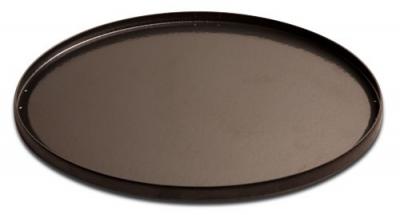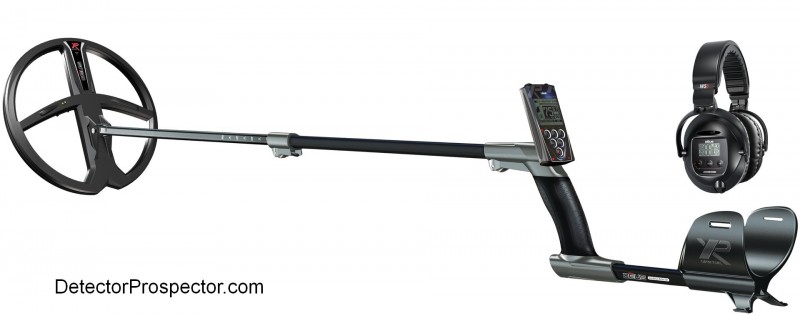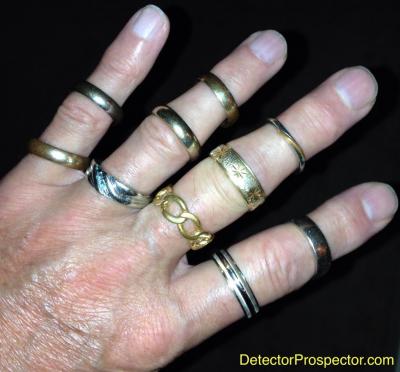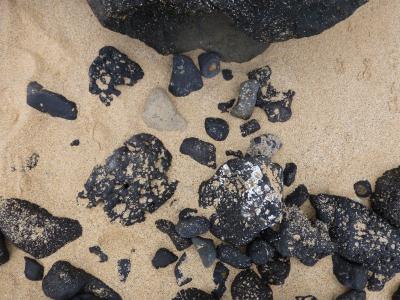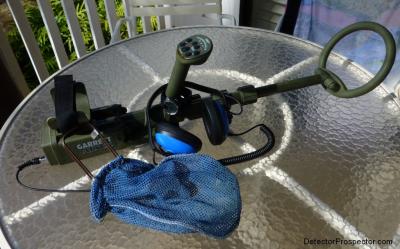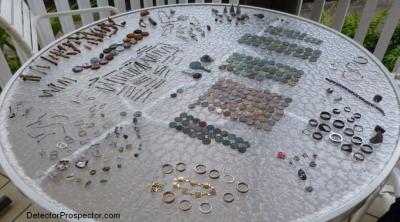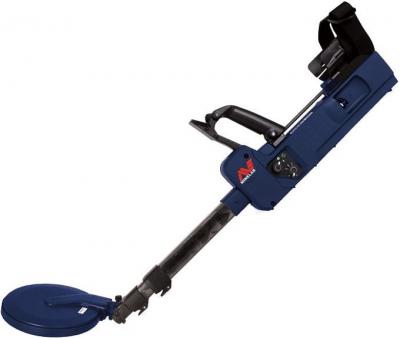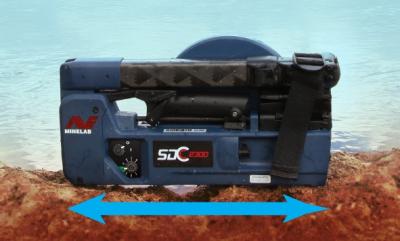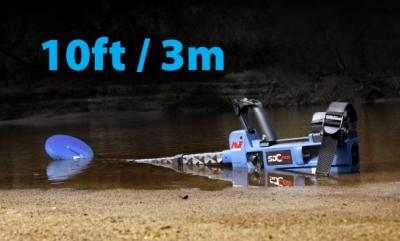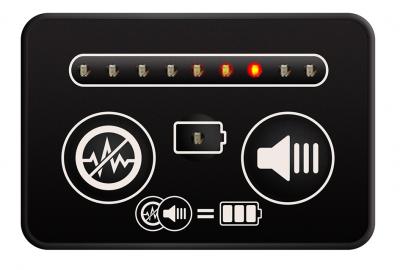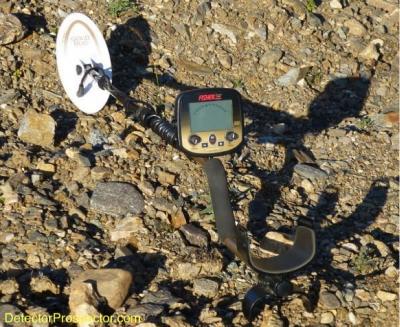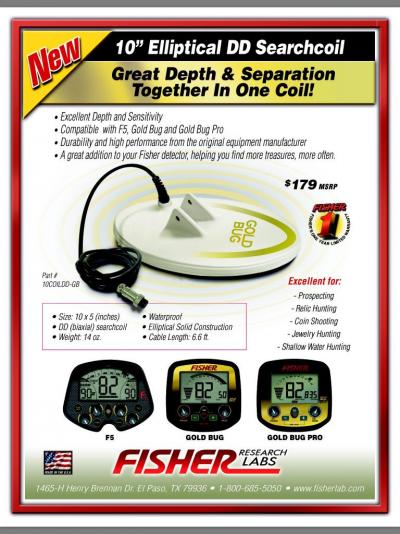-
Posts
19,773 -
Joined
Content Type
Forums
Detector Prospector Home
Detector Database
Downloads
Everything posted by Steve Herschbach
-
Hi Keith, TDI and ATX, what to do? I like the fact I can hip or chest mount my TDI but that is not enough. So right now I am holding on to my TDI for three reasons: 1. I can shut the ground balance completely off, and in ground that permits this it is a very powerful detector. I plan on doing a pretty extensive run of my ATX in default ground balance minimum mode against the TDI with ground balance off to see if the TDI has enough extra advantage if any in that situation to warrant holding on to it. Intent there is mostly hunting in sand. 2. For coins in trash, I can shut low conductive signals completely off with TDI, a very nice feature for coin hunting trashy sites. However, while the Infinium drove me a bit batty with audio barrage there is something less harsh about the responses on the ATX that make it more tolerable. So I am going to do a serious park hunt or two with both detectors along hunting and marking high conductive targets to see how it goes. One small problem with shutting low conductive tones off on the TDI is that mixed tone trash items are more likely to trick me, though I have learned usually to switch to all tones for a double check before digging. 3. I need to experiment more with the TDI ability to completely reject ferrous targets. Depth is lost, but how is it for target masking, see through, etc.? There is one weird factor. The ATX is cool looking. I was surprised that my wife thought it had a good look to it. When she says something positive about how a detector looks it means something. Certainly if I had to choose right now between the two the ATX would stay and the TDI go. I want to take real advantage of having both on hand however to learn more about both so am in no hurry to make a decision.
- 22 replies
-
- jewelry detecting
- garrett atx
-
(and 1 more)
Tagged with:
-
Infinium 10 x 14 inch Coil Cover PN: 1606400 Like Ken said this hangs out on each end. There is supposed to be a fitted coil cover for the ATX stock coil out now but they seem to be a secret, not on the Garrett website.
-
Hard to go wrong with the Gold Bug Pro. The AT Gold is for if you need to put it in the water. Any detector can be used in the rain. I have detected in rain for many a day with lots of detectors. Just drop a plastic bag over the control box, left open on the bottom to breath. A sandwich bag works great on the Gold Bug Pro. The orings on the AT Gold are tough so no reason to worry about failure. They are silicone lubed though and care must be taken to keep them clean. The tiny pins in the coil and headphone connectors are what you worry about. They get bent easily if you are not careful. Bottom line is the AT is a fine machine but I would only get one for prospecting if I needed to submerge it.
-
There was a recent find of a 117 ounce gold nugget in the Mt Monger area, south-east of Kalgoorlie-Boulder, Western Australia. Unfortunately so far I have only been able to find one very poor photo of it. What's up with that? The nugget is a bit different in that it is pretty long at 20" and narrow instead of a round lump. http://au.news.yahoo.com/thewest/regional/goldfields/a/20549863/faith-of-colleen-on-loan-to-museum/ Anybody have more information on how it was found or a better photo? I did find a photo on Facebook purporting to be the same nugget but I do not think it is.
-
Hi Merton, Discrimination, whether it is classic discrimination circuits or ground balance circuits really tend to be hard on gold nuggets since gold nuggets respond so close to ground responses. If you totally suppress the ground or the hot rocks lots of gold gets suppressed also. Nature if the beast unfortunately. By allowing more "noise" i.e. more ground noise or hot rock responses the signals from some gold can be enhanced. It is a direct trade off and balancing act as to what works best. Frankly, I run quiet until I hit gold, then tend to get progressively more aggressive in the tuning on a known gold location as it plays out. Sort of a desperation play as I have to dig some hot rocks or hot spots in the ground but it almost always gets gold I missed before. For whatever reason though sounds like you are on the money - the unit is not recovering from the rejection of the hot rock as fast as it should. You obviously have an analytical mind that will serve you well working with the XP especially given that you have a Gold Bug Pro to compare to. Seriously, you should email the manufactuer with your observations and volunteer to test new software versions. I do that sort of stuff, it is fun, and can get you a free detector now and then!
-
Wow, excellent report Merton, thanks! I was not aware of the hot rock notch on the XP DEUS. Sounds like an advanced version of what a Tesoro had on the old Diablo uMax, and an excellent idea. I have wondered why it did not catch on. Ground balancing is just another version of a discriminate circuit and the ability to adjust out two or more points on the scale would be quite valuable. Sounds like they have some good ideas but as you note they need to work with somebody like you on improving the gold program. I am sure they would listen to your feedback. Valuable stuff.
-
Hi Rick, It was my best outing ever water detecting. But the cold water of Hawaii and rough surf is keeping the ladies from getting into the water as much. My rings from Hawaii over the years include few women's bands, and not from lack of getting small rings. I have no problem hitting little toe rings and such. Like I said, it is all about site selection. I told my wife we need to go someplace with warmer water and a more affluent clientele. She is game of course. Those days I do not feel like it she is always like "get your butt out there and find me a ring!" You are welcome for the book. Hope it helps. The TDI is a good detector. I am not ditching mine yet just because I got an ATX.
- 22 replies
-
- jewelry detecting
- garrett atx
-
(and 1 more)
Tagged with:
-
Thanks Kenny. A problem I face is I am very passionate about my metal detecting and I can get pretty excitable over things. So I am making more effort to temper my posts to try and not make detectors appear to be something they are not. Not to pat myself on the back but I am very good at detecting and work hard at it. I can make almost any detector look really good, but it honestly is less the detector and more the person using it. That is a basic truth of the metal detector world that often gets overlooked - it is the operator that makes the detector, not the other way around. Just getting a good detector in no way assures that a person will do well metal detecting. It is all about knowing your equipment, site selection, and hard work. Although I was involved in detector sales for much if my life I never had to sell a detector. What I am really doing is selling metal detecting. I think it is one of the most exciting, fun, and truly challenging things a person can do. It can lead a person on adventures all around the world and bring you face to face with the most fascinating people. Detecting cuts across all walks of life and when you put a dozen true enthusiast together you will be amazed at the variety of people and what they do in "real life". Metal detecting has been incredibly good to me and I really enjoy sharing the passion I have for what for me is not a hobby, but a way of life. If I can turn just a few people on to what I have enjoyed my entire life I will have paid back the many people who helped me along when I had questions and needed help. The bottom line therefore is to not run out and buy a detector because I had success with it but to read between the lines and look at what it is I am really doing. I am out metal detecting and the detectors are just a tool of the trade. There are many, many fine detectors on the market now. We are blessed with a multitude of great machines. Part of the fun is learning about new detectors and what they do best, and they all are pretty good at something. Thanks to the Internet we can share that knowledge freely with people all around the world. It is a far cry from the day when I was a kid in Anchorage with a metal detector and nobody to talk to about it! Thanks for reading and sharing.
- 22 replies
-
- jewelry detecting
- garrett atx
-
(and 1 more)
Tagged with:
-

Headphones For Metal Detectors
Steve Herschbach replied to El Dorado's topic in Metal Detector Advice & Comparisons
I bought a Radio Shack rechargeable headphone at one point and it worked fine, as I am sure most wireless headphones would. My CTX 3030 came with a wireless headphone module. It is one of those great ideas that have not stuck with me. The problem is it is just another thing with a battery. Common scenario is I decide to go detecting, did not charge the wireless headphone module, and am not sure it is fully charged and will not go dead on me. So I grab my regular headphones instead. I have several sets of headphones which stay plugged into whatever I am currently using. Just grab and go. The headphone cord except in extreme situations (diving into thickets) does not bother me. Bottom line is I find myself just using my regular headphones even with the CTX. I suppose I should make the effort to use the wireless but the word I just used, "effort", is why it is not happening. -
Nice report, Merton, thanks! There is no doubt the XP is a top performer. It was good to hear from someone with you past experience and how easily you took to the machine. That says a lot about the detector right there. XP Deus Data & User Reviews
-
Well, back home safe and sound after a couple weeks in Hawaii with my wife. We visited the island of Kauai for the umpteenth time. We like the laid back vibe, made even more so by being familiar with everything. We do what we both like - she relaxes in the sun and I go metal detecting. And lots of walks and dinners together. I am glad I waited to post this as I have calmed down some now. A post a week ago would have been a bit much and made the Garrett ATX sound like God's gift to metal detecting. Now I can be more even handed about it. I will do up much more of a story for Steve's Mining Journal soon. This is just a post about how the Garrett ATX did for me in Hawaii. The back story is told at Steve's Mining Journal about prior trips made to the same location over the years. Hawaii has always been a pet project of mine as it is the most difficult environment I have even encountered for a metal detector. There is of course the salt water. There is also literally military grade electromagnetic interference (EMI) from military installations plus missile and satellite tracking stations. Finally, there is a mix of non-magnetic coral sands and volcanic basalt derived sands and cobbles. If you stick to the tan to nearly white sands you can get decent performance from many detectors. But when the basalt gets involved is where things get fun. Most prospectors are familiar with basalt rocks and the challenge they present in gold prospecting. Well, just take the same hot rocks and douse them in really salty water and heavy duty EMI and you have Hawaii. Multi frequency VLF detectors like the Fisher CZ or Minelab Excalibur do ok in in the stuff but lack any real punch. They do best in the whiter sands, but the basalt sands and cobbles really leave them feeling gutless. I went to PI detectors early on, and overall probably had my best results with the various White's Surf PI models. Again, however, they worked best in homogenous materials. Places where the white sands and basalt cobbles mixed gave the Surf PI fits as it hit on the basalt cobbles. In darker sand beaches it was near impossible to keep the machine steady over the bottom in the surf, leading to lots of false signaling. I tried several Garrett Infinium detectors in Hawaii and got tantalizingly close to the detector I wanted. The Infinium as a ground balancing PI could tune out the black sands and hot rocks and eliminate many of the false signals. But it introduced just as many if not more by an inability to play well with salt water and EMI. The interference in particular made the Infinium almost unusable at times. I really wanted a stable Infinium, and confirmed this idea by using the White's TDI in Hawaii. It seemed to solve the issues I was having with the Infinium and so I waited for White's to make a waterproof TDI. And waited. And waited. I waited so long that Garrett had time to take what they learned from the Infinium and another model, the Recon, and build a next generation PI, the Garrett ATX. I was cautiously hopeful that all the noise I had made over the years had been heard, but frankly, I was not getting my hopes up too much. On top of that, the good old days are gone. I used to spend a couple weeks in Hawaii years ago and never see anyone with a detector. This trip I saw people every day! Ok, often the same guy but also more different people detecting than probably all my previous trips combined. The competition has gotten fierce by comparison to the old days. And yet I just had my most successful trip to Hawaii ever. I recovered over a couple dozen rings with the ATX and half of those were gold or platinum. Some silver rings, a nice 14K bracelet, and a pile of coins and there inevitable PI junk. You will have to wait for the full story for details and more photos but here is a teaser of many of the good finds taken a few days before I wrapped up. Eight Gold and Two Platinum Rings Found by Steve Herschbach with Garrett ATX in Hawaii (Click on photo for larger version) You can probably see why a post earlier might have been a bit overly excited! This despite bad weather early on and all the extra detecting competition. The Garrett ATX is the best PI detector I have ever used for difficult water hunting. Hands down, no comparison. I have to qualify that by saying that what makes it shine is the severity of the conditions. A person buying it and using it on clean white sands in Florida would probably have a less enthusiastic reaction. There is a lot of confusion regarding ground balancing PI (GBPI) detectors like the Garrett Infinium or White's TDI. They do not air test well against good VLF detectors and indeed do not really perform all that well against them in mild ground. People never really understand what detectors like these are all about until they get into difficult ground. The kind of ground where the best VLF detectors lose half their depth, the GBPI detector just keeps plugging along, and all the sudden now have a big depth advantage. Not because they go so deep to start with, just that VLF detector fare so poorly in really bad ground. GBPI detectors only really shine in the worst conditions. Let that sink in because it is very important. Anyone reading this should not get the idea these detectors are the be all or end all for all circumstances. But when the going gets tough, when other detectors fall on their face, a GBPI detector like the Garrett ATX can be the answer. Tuning a detector like the Garrett ATX can really bother some people. There is this resistance to doing anything that reduces the theoretical max depth of the detector. As soon as you start getting into reducing settings the feeling is that "well, yeah, but now it does not go as deep". The reality is that any machine that can be run maxed out in bad conditions has left some performance on the table. You may be able to max settings in benign ground, but you should have to back off of max settings in really bad conditions. That is why the controls exist - to compensate for bad conditions. The goal is to be set as high as possible while getting stable performance. The ATX is a powerful detector, and so it should be expected the machine has to be dialed back in severe conditions. The ATX has three adjustments that affect the depth. The Gain control is the simplest. You decrease the sensitivity of the detector to help compensate for conditions that are introducing too much noise. Just like the Gain or Sensitivity control on a VLF detector. This control was lacking on the Infinium and is a major reason why the ATX is superior. There is the pulse delay, which Garrett labels as a discrimination control. It is, sort of. Without getting all technical on you it is also a sort of sensitivity control, in that increasing the delay or discrimination also eliminates signals from weak conductor targets like foil, hot rocks, or salt water. This is really the only control you have on the Infinium to deal with false signals and it serves a similar function on the ATX. Finally, you have the ground balance. The ground balance is basically another type of discrimination circuit or filter. The signal produced by the ground is determined and then eliminated. However, this comes at a cost. Items that read the same as the ground signal are also eliminated, and items near to the ground signal will exhibit reduced signals. The White's TDI makes it easy to demonstrate this. You can turn the ground balance completely off, and when you do so the machine air tests far better than it does when you turn the ground balance on. This is because of the subtractive nature of the ground balance circuit on the TDI. Also, because it has a manual ground balance, you can see the effect of tuning the ground balance control closer to and farther from a particular target response. Instead of tuning out the ground the control can be manipulated to tune out other items instead. It is just a basic discrimination circuit. Different ground balance methods can affect items to greater and lesser degrees so the example shown by the TDI should not be taken as being the same with all detectors. But the effect is real and does exist to some degree on all ground balancing detectors, both VLF and PI. So why use ground balance? That should be obvious - to tune out ground responses. If there is no detectable component in the ground you would be better off without the ground balance circuit. Such conditions rarely exist, but they do exist. Absolute pure white coral based sands are one of them. The ATX at its hottest will detect salt water however, and new to the ATX is the ability to ground balance out the salt signal instead of the ground signal, but you are trading some sensitivity for stability doing it. Long round about way to explain that when the Garrett ATX is turned on with factory default settings the ground balance setting is at a minimum. The ATX should be tried first with the factory default setting and on many beaches you will not want to ground balance it. Just leave the discrimination (pulse delay) at zero, set the gain as high as possible while still allowing the machine to be stable, do a frequency scan, and go. In Hawaii at my location however I could not do this. I could on clean sand but not in the cobbles I wanted to hunt. But first, a total surprise. My ATX was almost totally immune to the EMI that I had previously experienced on Kauai without even doing a frequency scan. The frequency scan was basically redundant. That one thing made the ATX a huge advantage for me before I did anything else. I would not have believed it had I not had a White's Surf PI along for backup and sure enough, when I fired it up, the EMI was there. It was discernible in the ATX non-motion mode but even then nothing to worry about. I. Do not know what Garrett did or if I have a magic ATX but this one thing alone really floored me. It absolutely eliminated my number one problem with the Infinium. Basalt cobbles in sand on Kauai A detector with all controls set to max is in theory getting the best depth. But if it is not stable you cannot work with it, so you have to adjust back to find the best balance. The ATX is a very powerful detector and so I found a combination of settings that worked for me to get quiet, stable performance. This is in no way being advertised as a setting to for you to use! It is what I did for this location and other locations will take different settings. In general, the more powerful all your settings can be the better while still being able to have a stable running detector. So the ATX with factory default (minimum) ground balance, zero discrimination (pulse delay), and max gain would be at its most powerful. The worse the conditions, the more you may need to dial the settings back. The problem is with all the settings maxed out the ATX is very sensitive to small gold, but that also means it picks up salt water and hot rocks. I played with the gain control and the pulse delay (disc) control looking for a balance that left the detector running quiet. A discrimination setting of three and a gain of seven made the ATX submerged in salt water run like a VLF. I periodically reduced the disc setting or bumped the gain higher and noise was introduced, so settled on the 3 and 7 setting for my Kauai beach. Then I found a fat basalt rock buried in the sandy bottom and ground balanced over it, eliminating the signal. I would be the first to admit these settings were probably aggressive and of course costing me some depth in theory, but I got what I have always wanted in Hawaii. A PI detector running quiet as a VLF and by that I mean just purring along with a threshold sound, and when it made a noise, it was because I had a target under the coil. Here is another way to look at it. A very hot detector will detect salt water. It will detect hot rocks. And it will detect things you want. EMI can also be an issue. The trick is to reduce the signals from the things you do not want to hear as much as possible while enhancing the good signals as much as possible. It may be letting unwanted signals through will also increase depth on desired targets a bit. It may also be true that too many signals from undesired targets will inhibit success. You have to decide for yourself where the balance lies. If maximum depth is the goal then digging more undesired targets may indeed pay off. In my case I had plenty of targets, so the goal was quiet, efficient operation. I would not hunt clean white sand set like this. I would have the settings maxed out. I had a strategy in mind here, and my goal was to detect in the basalt cobbles. I was not tuning the machine for maximum performance in the easy stuff, but for maximum performance in the worst stuff. I wanted to detect the places where targets were more likely to have been missed by other detectors. Finally, after one go with the stock coil, I switched to the 8" mono coil. A few reasons. First, it is easier to handle underwater and fits in depressions better. It can be pushed through sand ridges and is less likely to move on the shaft. And I could find items edge on with it easier than with the stock coil. By that I mean turn the coil on edge and drag it in the sand and it acts like a pinpointer on small surface targets. The edge of a mono coil is very sensitive. A smaller coil is easier to pinpoint with to start with anyway. And honestly, I used the 8" mono because I was worried about sand getting in the twist locks and giving me problems, possibly even seizing up the rod assembly. The 8" mono and shaft assembly was my sacrificial lamb. If it got totally screwed up my stock coil would still be fine. Garrett ATX with 8" mono coil (goodie bag attached to arm strap, waterproof watch on handle) I may as well relate now that I did have issues with sand in the twist locks but not as bad as anticipated. The lower two twist locks seemed just loose enough that at the end of every outing I just worked them back and forth and the rod in and out and they cleared. But the upper one gave me problems. It got sand inside that refused to come out, even after taking it off and working on it under running water for a half hour. For some reason that upper most twist lock was just a bit tighter to start with and the sand would not clear out. Yet it never quit 100%. I lost most of the ability to twist the lock but it still twisted just enough to hold the rod in place. I am asking Garrett for advice on where to drill a couple holes or maybe slots to see if we can get these things clearing sand a bit better. Overall I actually am ok with them but they need improvement. In other types of sand it could be a big problem. I am going to see if I can get my upper lock to loosen up similar to the lower two and will report back later. The rod assembly got scored up quite a bit from being extended and collapsed with sand in the assembly. I will post photos later. Nothing that bothered me but some might hate seeing their expensive detector getting ground up like this. I have to say at the end of the day the physical design and the rod assembly in the water were nothing short of brilliant. I have given the ATX low marks for prospecting as being a duck out of water. The waterproof design adds weight, complexity, and expense not required for most dry land prospectors. But in the water the ATX felt really, really good on my arm. It is slightly negative so will settle on bottom if released. But not much; it is essentially weightless on your arm underwater. The rod assembly was a dream. I was working in heavy surf with 40 lbs of lead weight on. I steadied myself many times by leaning on the ATX with absolutely no fear it would break, and the rod never slipped. I could get in the shallows on my knees and shorten the rod down as short as I liked. And just right, no fumbling for the right holes, just loosen a twist lock or two and put it right how I wanted it. Better yet, due to the three piece design, I could also extend the ATX to be longer than any detector I have used underwater. I was in 6 foot of water with just my snorkel in the air, and easily detecting around me. I do a lot of breath hold recovery in deeper water and the ATX was just so easy to adjust for whatever depth I was working at. So easy and so solid and tough that I 100% forgive any little work needed to sort out the twist lock situation. This is one really great handling detector underwater in rough surf conditions that would leave other detectors in serious danger of breaking. The 8" mono was perfect for me. It stayed where I put it and I pushed it around a lot. I learned quickly if I wanted to adjust the coil position to be flatter all I had to do is turn the detector over and push down on the nose of the coil. Maybe not as easy as pushing down on the heel of a coil with a rod mounted in the center instead of the rear but no big deal, mainly because the coil stayed put. After two weeks of heavy use I never had to adjust the coil tension and it showed no signs of having any issue with all the sand it ran through. I had no scuff cover, and the coil shows no sign of cracking, just your normal scuffing from use. The epoxy appears much improved from the old Infinium days. A weak point - that tiny spring loaded rod lock, the one you flip to disengage the rod and coil assembly. The tiny spring popped out on me once. I took it apart, made the spring end ninety degrees again, and it worked for most of trip, but slipped out again last day. Not a big deal but needs beefing up. Be sure when twisting the rod and cams while cleaning to not hold the detector body. You will be twisting against that little lever. Hold onto the rods themselves and twist the cams. We need to find out what the part number is for the coil and headphones connector covers. Everyone should have a couple extra. Better yet, a couple spare caps like are fixed to the back of the ATX to cover the male headphone connection when not in use. One of these to put over the male coil attachment point inside the housing would be very helpful when rinsing and cleaning the ATX. Take the coil off, put the cap on, and now no worries while cleaning. I will find out the part numbers and pricing for those and get some and suggest ATX owners do also. OK Steve, quit delaying! What about the rings? I saw no point on beach hunting with all the competition. One guy in particular walked the beach a couple times every day with a Surf PI. I saw a couple Surf PI detectors at work, a Minelab Excalibur, and a Tesoro Sand Shark or Piranha. They all walked the beach and only the Excalibur guy ventured into the trough when it was calmer once. I spent all my time in the surf or deeper water with a weight belt and mask and snorkel. I recover targets by fanning or digging. And I went looking for mixed coral/basalt harder bottoms instead of deep sand. I played on the beach a bit and hit deeper sand underwater but basically all my finds came off of more solid bases. I am not going to say the ATX was some kind of super depth monster. That would be misleading and really missing the entire point. I have no doubt it was getting as good as depth as could be wrung out of the conditions. I was easily getting nickels down to ten inches in the basalt, maybe a tad deeper but honestly it is hard to tell recovering targets underwater while holding my breath in the surf. The real thing I am trying to relay here is the ATX was rock solid, just like using a good VLF above water, but in the worst detecting conditions I have ever encountered. It allowed me to just get on with the business of detecting targets and recovering them. If I was lacking for targets maybe fighting for another inch would be the name of the game but I never ran out of targets. The rings just banged! Nickels hit hard. By virtue of the ground balance system large junk goes low tone and I ignored many low tone targets. That cost me some dimes, copper pennies, and quarters but that is ok. Nickels, zinc pennies, and rings go high tone. As do sinkers, bottle caps, hair pins, and aluminum. Still, being able to ignore low tone targets upped my odds some. Though I dug a lot of low tones also just to learn more and frankly, because I have a hard time passing targets. You just never know for sure until you dig them and I was there to dig targets. Still, this photo shows my target mix skewed to high tone targets. With the exception of a few large items discarded at the trash can this is every item I dug over the two week period and about 50 hours of detecting time in the water. Steve's Finds in Hawaii with Garrett ATX (Click on photo for larger version) Another benefit with the ATX is the adjustable target volume and threshold, a real boon in an underwater detector. I had brought Gray Ghost Amphibian phones with me that started out loud enough but then got too quiet to hear, so I had to FedEx a set of Garrett phones in quick. I like the sound of the Ghosts better but not if I can't hear them. I surmise the sound chamber was filling with water and so will return them to get checked out. First time DetectorPro phones ever let me down. The Garrett phones have a lower tone but worked just fine. The volume and threshold control on the ATX makes them much nicer to use since they can be set comfortably for both above and below water use even though they have no volume control themselves. You can even set the volume on the fly easily while underwater. This is a very nice thing that most underwater detectors lack. I have read a few posts by people very concerned about the placement of the headphone connector. Total non-issue for me. It is under my right elbow and was never a concern at any time. Icing on the cake? The ATX retains all settings when turned off. Once I found my magic settings I was so happy with how the ATX was running I was afraid to change anything and did not have to. Just turn it off, turn it on, and ready to go. Everything is just the way you left it. This is very important with the ground balance setting. It is the one setting you have no idea where it is set. I wish and am suggesting that when the detector is manually ground balanced the LED indications reflect the entire range and show you where you end up at for future reference. Right now the LEDs simply follow to audio and reduce to nothing when the unit is ground balanced. But where am I and can I get back there? You have no idea and neither did I. All I knew was my ATX was running great and recovering targets at what I thought was good depth so I left it be. I used rechargeables exclusively. I kept rough track of detecting time and charged up about every ten hours. Again, it was nice being able to pull batteries out, charge, reinstall, and when the detector was turned on again no tuning was required due to the retained settings. I carefully looked for water in the battery compartments each time but never saw a drop. I have total faith in the waterproof integrity of the ATX after what I put it through. I just got back and blasted this report out but will probably edit it a bit to smooth it up over the next couple days. I will also post a more story like version with more details and photos on my journal in the next couple days. I am cleaning up a few of the rings. There is one very old class ring I thought was junk but is encased in sand and lime I am dissolving away and I have a couple silver rings to clean up. Once again the big diamond eluded me but no complaints here, it was my best haul ever for a beach hunting trip. In no small part due to the Garrett ATX but I will take some credit also for really hitting the water hard. Again though, do not take this as some kind of crazy ATX testimonial. Pay attention to my caveats. Beach hunters in clean white sand with tons of hair pins have less to be excited about here. But if you have black sand beaches or worse, the ATX is a machine to at least be aware of. I just can't help it though, I really like a detector that puts gold and platinum in my pocket! Things I most wanted? An indication of what the ground balance setting is and an ATX version of the 14" Infinium mono coil. Thing I liked most? The way the ATX handled in the water and the way it adjusted up to handle the conditions. My last detecting nut cracked - thanks Garrett and especially Brent Weaver for obviously listening to my suggestions all these years! I would like to learn more about this detector as there is much it is capable of. How exactly does it compare with factory default minimum ground balance mode versus PI detectors that have no ground balance at all? I tried the no-motion mode a bit but saw no real value for what I was doing - there has to be more to it that is of value in other situations. Most importantly, what combination of pulse delay, gain, and ground balance is optimum for various locations and targets? I found some that worked for me but I am not swearing they were the best settings possible. I admit to focusing more on detecting than fiddling and so it is hard to get me to stop and do comparative tests when detecting time is at a premium. I look forward to seeing what works for others and will add what I can as I learn more about the ATX myself. Steve Herschbach This post has been promoted to an article
- 22 replies
-
- jewelry detecting
- garrett atx
-
(and 1 more)
Tagged with:
-

Minelab SDC 2300 Product Details
Steve Herschbach replied to Steve Herschbach's topic in Minelab Metal Detectors
Hi Rick, Thank you for the very thoughtful response! I know I am not a big fan of high prices and I am a big fan of competition. The more the merrier. I do think Minelab benefitted from a "perfect storm" if you will of high gold prices and gold rushes in countries where buying practices verge on irrational. There is an almost superstitious belief in certain detector models overseas and the buyers cannot be swayed to try anything else. The GPX 4500 became the object of intense desire and sold far faster than they could be built at one point. An extremely expensive detector in extremely high demand led to the kind of sales one does not duplicate easily if at all. It was a "detector bubble" and like all financial bubbles at some point you reap the hangover. -

Minelab SDC 2300 Product Details
Steve Herschbach replied to Steve Herschbach's topic in Minelab Metal Detectors
When I do up my detector guide I have to weigh detectors myself to get real world weights including batteries. The only weight that matters is what is on your arm, and excluding battery weight gives a false idea the detector is lighter than it is in actuality. The detector ships with four alkaline C cells and weight should be quoted with them in the detector. Four each Energizer alkaline C cells weigh 9.46 ounces or 0.6 lbs giving a total weight of 5.9 lbs.Steve's very personal detector weight conversion chart: Under 3.0 pounds equals Very Light Weight Detector 3.0 - 3.99 equals Light Weight Detector 4.0 - 4.99 equals Medium Weight Detector 5.0 - 5.99 equals Heavy Metal Detector 6.0 - 6.99 equals Very Heavy Metal Detector For reference a GPX 5000 on arm is 5.3 pounds (battery on back and so not counted) and Garrett ATX is 6.9 lbs. -

Minelab SDC 2300 Product Details
Steve Herschbach replied to Steve Herschbach's topic in Minelab Metal Detectors
The basic pulse induction detector sends a pulse of current through a coil in the search head. At the end of the pulse the current is shut off. Once a current is running it does not like to stop suddenly and there is a "boomerang effect" that briefly induces a very large voltage spike across the coil. Once this transient spike dissipates, the detector can go into receive mode. The intentional portion is referred to as the "transmit pulse" and the follow up spike the "flyback pulse". There are different ways of looking at the situation but in most cases the flyback pulse is viewed as a problem to be dealt with. The sooner the detector can receive or "sample" the better it is at detecting quickly disappearing signals from small gold. The whole MPF thing is just another acronym for our collection referring to Minelabs method of dealing with the flyback pulse and achieving greater sensitivity to small gold. Whether it is SD based or GP based is all rather beside the point. All that matters is how it works in the field. I expected you to come out swinging harder on the price Rick. On other forums you have stated the SDC 2300 is "DOA" at certain price levels. How do you account for the GPX being the most expensive consumer detector sold and yet sold in huge numbers world-wide? I am not arguing with you though and indeed please voice your opinion on the subject. Until the unit is actually on the market Minelab has time to gauge responses and set the price wherever they want. You have a very valid point on the SDC versus ATX for the price and what they offer. I think you are missing something though. The SDC is not bring priced against the Garrett ATX. It is being priced against a GPX 5000 and will be marketed world wide to people who will not consider anything that does not say Minelab on it. The SDC is compact, waterproof, simple to operate, and most importantly, runs on regular batteries. At two thirds the price of a GPX if they can get just a few Africans to use it and find gold with it then they may have the next hot machine. The way things work over there defy normal marketing beliefs and ideas. -
From http://www.minelab.com/usa/consumer/knowledge-base/news?article=215928 1/31/14 Minelab SDC 2300 - Click on image for larger picture Minelab is pleased to provide further information about our exciting new SDC 2300 GOLD detector scheduled for release in mid-2014. Compact Size - Folds to small portable size, 8 ½ ” (216mm) by 16” (406mm). Fits into carry-on luggage and most backpacks. Rugged & Assembly Free - Military grade construction, one piece detector designed to perform in the toughest conditions. Waterproof Capability - Fully submersible to 10’ (3m) for detecting riverbeds and shorelines allowing you to transition with ease from land to water. Now you can use your Minelab GOLD detector in all wet weather conditions allowing you to stay on the goldfields for longer, even in the rainy season. Easy Patch Hunting - Search quickly and efficiently in hard to reach and remote places to find those elusive gold bearing clustered deposits. Easy-to-use Controls LED Indicators - Shows target signal strength, threshold level and battery status. Audio Control - Adjusts threshold level and low/high audio tone to suit user preference. Noise Cancel - Easy button press to automatically reduce external interference. Sensitivity - Eight position adjustments for optimum target identification in varying ground conditions. MPF Technology - MPF (Multi Period Fast) technology incorporates extremely fast Pulse Induction switching between Transmit (Tx) and Receive (Rx) detector signals. Therefore minimal residual transmit signal is present during the receive cycle, enabling clear sharp detection of very small gold. Standard Accessories (included with detector) - Headphones (non waterproof) Optional Accessories (not included with detector) - Headphones (Waterproof), Carry Bag Detector Technical Specifications Coil - 8" Round Monoloop Audio Output - Built-in speaker, Koss 100 Ohm headphones (standard accessory - supplied), Koss waterproof headphones (optional accessory - not supplied) Display - 9 LEDs indicate detection, battery status and Threshold level, 1 Low battery warning LED Length - Extended: 1500mm (59.1"), Collapsed: 400mm (15.7") Weight (Excluding Batteries and Headphones) - 2.4kg (5.3lbs) Operating Temperature Range - 0°C to 50°C (32°F to 122°F) Storage Temperature Range –33°C to 70°C (–27°F to 1°F) Batteries - C Cell 4 x 1.5V Alkaline (supplied), 1.2V NiMH (optional), 1.2V Ni-Cad (optional) Sensitivity - 8 step position adjustment Noise Cancel - Automatic scanning Ground Balance - Automatic Ground Tracking (AGT), Fast Ground Balance Threshold - 9 audio levels Audio Pitch (Tone) - Low: 550Hz ±15, High: 720Hz ±15 Transmission - Pulse Induction Technology - Multi Period Fast (MPF) Optional Accessories - Waterproof Headphones, Carry Bag
-
The Gold Bug Pro had turned into one of my favorite prospecting machines, especially for trashy areas. Ray Mills and I have been bugging (get it?) Fisher to put the machine out with the 10" elliptical coil as stock. In my opinion it is the best all around coil for the detector and also makes it look like it should as a prospecting detector and cousin to the Gold Bug 2. Right now you can only get the coil as part of a package or as an after purchase accessory. The coil works on the Fisher F5, Gold Bug, Gold Bug Pro, and Teknetics G2.
-

Headphones For Metal Detectors
Steve Herschbach replied to El Dorado's topic in Metal Detector Advice & Comparisons
Hi Jim, Great to see you posting here and hope it will be often. I know you have a lot to contribute. I think Black Widows are in my future but they should have called them Mickey Mouses cause that is what you look like when wearing them! -

Land Version ATX, Here's A Start......
Steve Herschbach replied to a topic in Garrett Metal Detectors
Hopefully a dry land version would include coils with standard connectors. The waterproof connectors are needlessly delicate and the oring lube collects dirt if not handled very carefully. I also doubt the Infinium coils are fully tuned for the ATX and so ATX specific versions would be welcome. My most desired coil right this moment is the 14" elliptical mono since the Infinium mono coils do not work at all on the ATX. -

Land Version ATX, Here's A Start......
Steve Herschbach replied to a topic in Garrett Metal Detectors
Really, the thanks is mine Paul. I am sure Garrett is paying attention to your posts. -

Land Version ATX, Here's A Start......
Steve Herschbach replied to a topic in Garrett Metal Detectors
A great start Paul! i do think it would look better with 10" elliptical DD as the small coil makes control box look larger than it is and it is a coil more people would use. Still, dropping from 7 pounds to 4 pounds on the first pass is no small feat. My first thought on considering such a concept was for controls on end of handle like on the current ATX but if I was doing it now I would flush mount control pad into the control box. The ATX retails settings and after a bit controls are rarely touched. This would also allow for an easy chest or hip mount conversion if desired. Too bad the circuit board is so long because otherwise I would put it in a Goldmaster 3 box. The current ATX design is brilliant for water use, with the exception of sand jamming the locking rings, which has not been as bad as I feared but needs to be improved. Otherwise it is a great water design. But for prospecting the waterproof design misses the mark by a long shot. Most metal detector prospecting takes place in arid conditions and the waterproof design is a duck out of water for that application. It is a superb prospecting circuit and as such deserves a dry land design to come to full fruition as a prospecting detector. -

Tesoro New Detector - The Cazador
Steve Herschbach replied to Jack and dog's topic in Compass, D-Tex, Tesoro, Etc.
"So hope it's a new gold detector" I very much doubt that, so I hope they prove me wrong. More likely if they are smart they are taking tips from Keith Southern on building a better machine for hunting in thick nails. Something more along the lines of a Vista Gold but with expanded discrimination range would be a good fit for them. -

Headphones For Metal Detectors
Steve Herschbach replied to El Dorado's topic in Metal Detector Advice & Comparisons
All the Minelab PI units prior to the GPX were noted for weak audio, creating a cottage industry for aftermarket amplifiers. When the GPX came out and introduced the new battery it also included an amplifier integrated into the new battery. This pretty much solved the problem with the GPX series and mine runs great with my Nugget Busters.Anyway, the issue is not so much your headphones but the GP 3000 audio output. -

Headphones For Metal Detectors
Steve Herschbach replied to El Dorado's topic in Metal Detector Advice & Comparisons
I wrote a little article on the subject at Steve's Guide to Headphones for Metal Detecting Here is a good article on the technical aspects http://www.head-fi.org/a/headphone-impedance I hate to say it but best solution is plug them in and try them. Headphones I love you may hate! But for what it is worth I use and have abused DetectorPro headphones for years. They make good stuff and am using Nugget Busters these days. I was a Gray Ghost fan until I lost hearing in my right ear so now I prefer dual volume controls. I also took a liking recently to the Sun Ray Pro Gold. Real leather muffs do not sweat as much otherwise they are similar to Gray Ghosts with dual volume controls. I would like to get some Killer B headphones someday. A friend had a set and I liked the look and feel. I like tighter headphones and some people do not. When I dig aggressively the Koss headphones that come with a GPX fly off my head. I guess my head is on the smaller side.

